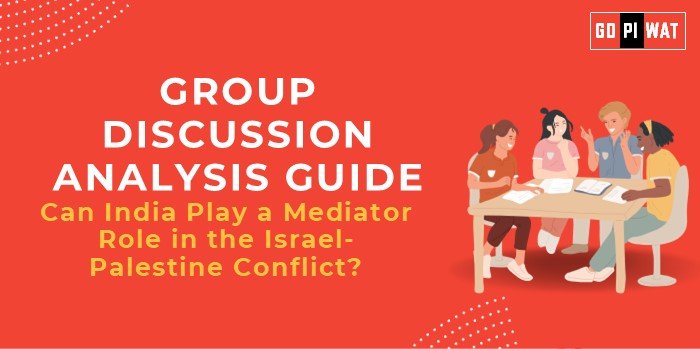📋 Group Discussion (GD) Analysis Guide
🌍 Can India Play a Mediator Role in the Israel-Palestine Conflict?
🌟 Introduction
The Israel-Palestine conflict, one of the longest-standing geopolitical disputes, has posed significant challenges for global diplomacy. India, with its historical stance of non-alignment and evolving partnerships in West Asia, is seen as a potential mediator in this deeply divisive issue.
📊 Quick Facts and Key Statistics
- 💼 India-Israel Trade: $10.8 billion in FY 2022-2023, doubling from $5.3 billion in 2018-2019, demonstrating growing economic ties.
- 🤝 India-Palestine Aid: $35 million contributed to UNRWA since 2018, including a $5 million annual commitment.
- 🗳️ UN Resolutions Supported: In December 2024, India reaffirmed its stance on a two-state solution by supporting a UN resolution calling for Israel’s withdrawal from occupied territories.
- 🌍 Diaspora Presence: Approximately 85,000 Indian-origin Jews in Israel; minimal presence in Palestinian territories.
🤝 Stakeholders and Their Roles
- 🏛️ India: Balancing robust ties with Israel and long-standing support for Palestine.
- 🇮🇱 🇵🇸 Israel and Palestine: The primary parties, seeking resolution under vastly different terms.
- 🌐 UN and International Bodies: Providing platforms for mediation and resolutions.
- 👥 Indian Diaspora: Significant presence in Israel highlights India’s stakes in regional stability.
📈 Achievements and Challenges
🏆 Achievements:
- ✔️ Strong trade growth: Trade with Israel grew from $5.3 billion in 2018-2019 to $10.8 billion in 2022-2023.
- 🤝 Palestinian Welfare Contributions: Steady contributions to Palestinian welfare through UNRWA.
- 📢 Global Advocacy: Consistent advocacy for a peaceful resolution at global forums like the UN.
⚠️ Challenges:
- 📉 Perceived Neutrality: Growing defense and trade ties with Israel may compromise neutrality.
- ❌ Minimal Influence: Limited presence or influence in Palestinian territories.
- ⚖️ Domestic Backlash: Risk of political backlash over perceived bias.
🗣️ Effective Discussion Approaches
💬 Opening Approaches:
- 📊 Highlight trade statistics and India’s aid commitments.
- 🗳️ Reference India’s recent UN stance on the two-state solution.
- 🔄 Begin with India’s legacy of non-alignment and peacekeeping.
🤔 Counter-Argument Handling:
- 💡 Recognize India’s growing alignment with Israel and address by citing its balanced voting record at the UN and aid to Palestine.
- 🌍 Reference global examples like Egypt’s mediation successes to reinforce feasibility.
📌 Strategic Analysis of Strengths and Weaknesses
✅ Strengths:
- ✔️ Historical neutrality.
- 📈 Global stature.
- 🤝 Economic ties with both sides.
❌ Weaknesses:
- 📉 Limited influence in Palestinian territories.
- ⚠️ Risk of perceived bias.
🌟 Opportunities:
- 🌐 Leverage UN involvement.
- 📢 Bolster India’s global leadership profile.
⚠️ Threats:
- 🚫 Potential alienation from regional or domestic actors.
- 🌏 Geopolitical risks.
📚 Structured Arguments for Discussion
- 🟢 Supporting Stance: “India’s growing global stature and balanced diplomatic approach position it well to mediate.”
- 🔴 Opposing Stance: “India’s deepening ties with Israel may undermine its neutrality in mediation.”
- ⚖️ Balanced Perspective: “India’s credibility depends on balancing its strategic partnerships with Israel and its consistent support for Palestinian rights.”
🎓 Connecting with B-School Applications
📖 Real-World Applications:
- 🌍 Lessons in stakeholder management and ethical diplomacy.
❓ Sample Interview Questions:
- 💬 “What challenges might India face in balancing its role as a mediator?”
- 🧐 “How can economic ties influence political neutrality?”
💡 Insights for B-School Students:
- 📘 Learnings in conflict resolution, managing diverse stakeholder interests, and ethical leadership.


